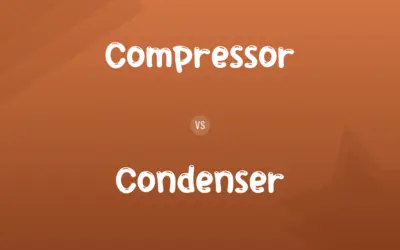Proportion vs. Balance: Difference and Comparison
Edited by Muazma Batool — By Muneeza Rehman — Published on March 19, 2024
Proportion refers to the harmonious relation of parts to each other or to the whole, while balance involves the equal distribution of visual weight in a composition.

Difference Between Proportion and Balance
Proportion and balance are fundamental concepts in design, art, and architecture, but they serve different purposes. Proportion is about the relationship and size of elements relative to each other or to a whole, aiming for a pleasing or logical arrangement. For example, in architecture, the size of a window compared to a door is considered through proportion. Balance, on the other hand, is concerned with distributing elements so that they create a feeling of equality in visual weight. This can be achieved through symmetry, as in classical architecture, or asymmetry, as seen in modern designs.
Muneeza Rehman
Mar 19, 2024
Proportion often deals with mathematical ratios and scales, such as the Golden Ratio, which artists and architects have used to achieve aesthetic harmony, balance involves intuition and perception. It's about how different elements (colors, shapes, textures) are placed to create stability or dynamism within a space or composition. For instance, a painting might use bright colors on one side balanced by a large dark shape on the other.
Muneeza Rehman
Mar 19, 2024
In practical application, proportion can influence the overall aesthetics and functionality of a design, making spaces feel more comfortable or objects more usable. Balance, conversely, affects the mood and focus, guiding the viewer's eye across the work in a deliberate way, contributing to the piece's emotional impact or narrative.
Muneeza Rehman
Mar 19, 2024
Both concepts, while distinct, often overlap and interact within a composition. A well-proportioned space can feel balanced, and a balanced composition can enhance the perception of proper proportions. Understanding and manipulating these principles allows creators to produce works that are not only visually appealing but also effectively communicate their intended message or function.
Nolan
Mar 19, 2024
The difference also extends into the perception of the viewer or user. Proportion relates to the sense of harmony and order in the relationships between parts, affecting the perceived beauty or coherence of an object or space. Balance, by influencing how attention is distributed across a composition, can evoke feelings of calm, tension, or movement, significantly impacting the emotional response to a work.
Muneeza Rehman
Mar 19, 2024
Proportion vs. Balance Comparison Chart
Definition
The relational sizing of elements to each other or to a whole.
The distribution of visual weight across a composition.
Muneeza Rehman
Mar 19, 2024
Focus
Mathematical ratios and harmonious relationships.
Equalizing visual forces or elements.
Muneeza Rehman
Mar 19, 2024
Application
Art, architecture, design to achieve aesthetic or functional harmony.
Art, design, photography to create visual stability or dynamism.
Muneeza Rehman
Mar 19, 2024
Perception
Influences aesthetics, usability, and comfort.
Affects mood, attention, and emotional response.
Jonathan
Mar 19, 2024
Proportion vs. Balance Definitions
◉Proportion
The ratio between elements in a design ensuring harmony.
The building's proportions give it a majestic appearance.
Muneeza Rehman
Feb 21, 2024
◉Balance
Achieves visual stability through equal distribution.
The painting's balance is achieved through contrasting colors.
Muneeza Rehman
Feb 21, 2024
◉Proportion
Affects usability and comfort in design.
The chair's proportions make it exceptionally comfortable.
Muneeza Rehman
Feb 21, 2024
◉Balance
Utilizes symmetry or asymmetry for dynamic compositions.
The garden is designed with perfect balance, despite its asymmetry.
Muneeza Rehman
Feb 21, 2024
◉Proportion
Critical in architecture for visual harmony.
Proportion is key to the timeless beauty of classical architecture.
Leo
Feb 21, 2024
◉Balance
Guides the viewer’s eye through a composition.
Balance in this photograph is created by the placement of light and shadow.
Muneeza Rehman
Feb 21, 2024
◉Proportion
Uses mathematical ratios for aesthetic appeal.
Artists use the Golden Ratio for pleasing proportions.
Muneeza Rehman
Feb 21, 2024
◉Balance
Essential for creating engaging and stable visual works.
Good balance makes the advertisement visually appealing.
Olivia
Feb 21, 2024
◉Proportion
Ensures elements within a space are harmoniously sized.
The room's proportions are perfectly balanced for its size.
Muneeza Rehman
Feb 21, 2024
◉Balance
Influences the emotional tone of a design.
The balance between the elements gives the room a calm feeling.
Leo
Feb 21, 2024
◉Proportion
A part or amount considered in relation to a whole
What is the proportion of helium in the atmosphere?.
Muneeza Rehman
Feb 20, 2024
Proportion vs. Balance Frequently Asked Questions
How does balance affect a viewer's perception?
Balance affects where the viewer’s eye is drawn, influencing mood and focus within the composition.
Muneeza Rehman
Mar 19, 2024
Can a design be proportionate but not balanced?
Yes, a design can have harmonious proportions but may lack visual balance if the elements are not well-distributed.
Muneeza Rehman
Mar 19, 2024
What is the difference between proportion and balance?
Proportion refers to the relative size and harmony of elements, while balance is about the distribution of visual weight.
Muneeza Rehman
Mar 19, 2024
How do proportion and balance interact in design?
They work together to create compositions that are both aesthetically harmonious and dynamically engaging.
Olivia
Mar 19, 2024
Why is proportion important in architecture?
Proportion ensures that buildings are aesthetically pleasing and functionally sound, affecting both beauty and usability.
Jonathan
Mar 19, 2024
Can balance be achieved with asymmetry?
Yes, asymmetrical balance uses different elements that have equal visual weight, creating dynamic and interesting compositions.
Lucas
Mar 19, 2024
What is visual weight in the context of balance?
Visual weight refers to the perceived heaviness or lightness of an element, influenced by its size, color, and density.
Muneeza Rehman
Mar 19, 2024
Are there mathematical rules for achieving proportion?
Yes, there are mathematical guidelines like the Golden Ratio that help achieve pleasing proportions.
Olivia
Mar 19, 2024
What role does color play in balance?
Color can significantly affect balance by altering visual weight; bright or dark colors can create focal points that balance a composition.
Jonathan
Mar 19, 2024
How do proportion and balance contribute to usability?
They ensure that designs are not only visually appealing but also functional and comfortable for the user.
Henry
Mar 19, 2024
Content Creators
Written by
Muneeza RehmanAt Comparisons.wiki, Muneeza skillfully navigates the vast sea of information, ensuring clarity and accuracy as the lead content editor. With a keen eye for detail, she curates every comparison to enlighten and engage readers.
Edited by
Muazma BatoolAs a content editor, Muazma Batool is not just a grammar guru but a creative mastermind who breathes life into every word. With an eagle eye for detail and a passion for storytelling, she transforms bland text into engaging content that captivates audiences and drives results.

































